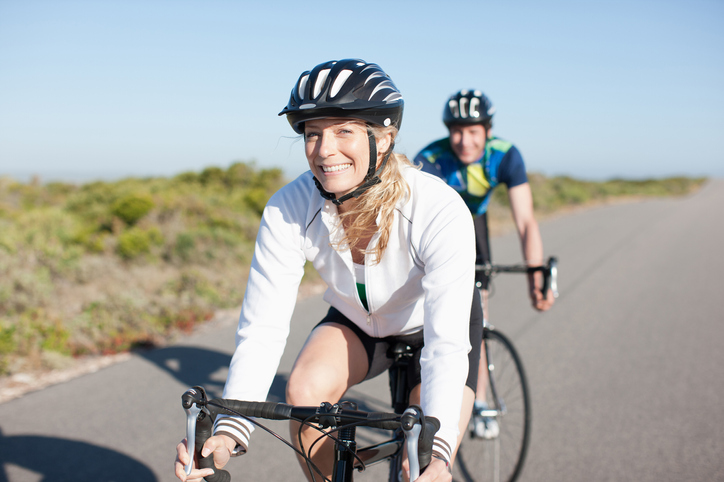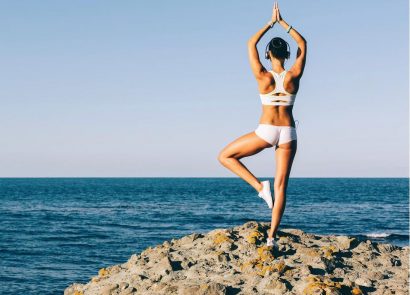It’s official: cycling was the UK’s most popular lockdown sport. Here’s how to get those cycling benefits and why getting on the saddle should be your new activity for the summer and all year round!
What are the benefits of regular cycling?
Sure, workouts that take place within the four walls of a gym have their place, but there’s nothing like free-wheeling with the wind in your hair and embracing nature in its true form when you go cycling.
And, while the latest indoor cycling technology might make the sport more accessible, you could be missing out on the vital health benefits that you would normally experience when out on the open road, such as reduced stress and decreased risk of depression, according to the experts.
Cycling helps with weight loss
Visceral fat is found on your internal organs, such as your liver, stomach and intestines, so in other words, it’s the kind that you carry around your midriff. Cycling is a cardio workout and helps to burn this, especially when done at the correct duration and frequency, says performance coach, Jamie Lloyd.
“In terms of average cycling speed, aim to cycle for two minutes when the road is flat at an RPE [rate of perceived exertion] level of five [when you’re riding consciously quicker, but are still able to talk] and then crank it up to a level seven. Doing 10 of those for half an hour will be a great fat-burning workout.”
It boosts your mood
“For those that simply loathe the idea of pounding the pavements, another option with similar mood-boosting benefits is cycling,” says Steven Virtue, fitness content and programming manager at Total Fitness.
“You can make the most of an hour outside by getting on your bike and giving your legs a good workout. Whether you’re living with a housemate or looking for ways to occupy the kids, cycling is something that can be hugely enjoyable as a group activity. Remember, the harder you work the more serotonin your body will produce, so if you’re in need of a bigger boost, opt for a more challenging road cycle route with inclines, or simply take the longer way.”
If you’re keen on pounding the pavements, you’ll probably be familiar with the runner’s high, but is there such a thing as the cyclists’ equivalent? Well yes, apparently. “Cycling supports a reduction in depressive symptoms which, in turn, helps you to feel more positive,” says Professor Mathew Wilson, head of sport and exercise medicine at the Institute of Sport Exercise & Health.
“Cycling releases serotonin – a mood neurotransmitter – which enhances self-esteem and self-confidence.” It’s also a great way to reduce your stress levels. “Exercise in general will produce endorphins which will lower your cortisol levels and this can help the immune system, thyroid and even the reproductive system,” says Luisa Valenti, co-founder of Your Body Programme.
Cycling benefits your mental health
“Aside from the obvious physiological benefits, such as better lung and heart functionality, strengthened bones and increased muscle form, cycling can be a supremely effective agent in maintaining mental health,” explains Mark Brown, business development director at Evans Cycles.
“Aerobic exercise like cycling reduces stress and anxiety, as well as increasing your self-esteem. It can also help combat depression through the regulation of cortisol and the natural release of endorphins in your brain.
“For many people, cycling also offers an unparalleled sense of freedom, much like a child gaining their first taste of independence and exploration. In addition to this, it can also help promote mindfulness by focusing your brain on the present moment, instead of juggling a multitude of thoughts.
“The psychological effects of cycling are also somewhat heightened in the fresh air of the great outdoors. Whether you’re a leisure rider, commuter, mountain-biker, tourer or a complete beginner, it’s important to know the mental benefits of pedal power.”
Cycling keeps your heart healthy
A healthy heart is something that we may take for granted, but with the British Heart Foundation suggesting that heart disease in women is twice as deadly as breast cancer, looking after our tickers is essential for protecting us against cardiovascular diseases. “Cycling strengthens your cardiovascular system, which has endless benefits to your overall health,” says Luisa Valenti, co-founder of Your Body Programme. “It strengthens your heart, making it more efficient at pumping blood around your body and improves your lung capacity. This decreases the risk of heart attacks, strokes and high blood pressure.”
Cycle for a healthier commute
New research suggests that people who walk or cycle to work are at lower risk of death or serious illness compared with those who commute by car, so if you’re preparing to head back to the office, try those cycle routes instead. You’ll also be geared up to tackle your 9am project meeting, says Professor Wilson: “There are two main benefits of cycling as a mode of transportation: firstly, research has suggested that we’re more productive at work if we’ve completed physical activity beforehand. Secondly, cycling saves time, money, and has an incredibly positive impact on minimising global pollution levels.”
Cycling will help you sleep better
Have you ever been so exhausted from a workout that it’s made you want to crawl back into bed? Us too, and for good reason. “Cycling encourages the release of the human growth hormone (HGH) into your bloodstream during sleep,” explains Jamie. “This helps your body to fall into a ‘proper sleep’ and a boost from cycling can help those who find it difficult to nod off.”
We should mention that any high-intensity exercise will cause short-term spikes of HGH levels, but with your body’s exertion efforts after a cycling workout, you’ll be in the land of nod in no time.
Strength training will help to build leg muscle
Fat-burning? Tick. Sleep-inducing? Tick. But what about the muscles used in cycling and the impact on them?
“The resistance element of cycling strengthens your leg muscles – your quads, glutes, hamstrings and calves in particular and, by building strength in these muscles, your bone density will improve and you’ll reduce your risk of osteoporosis,” states Luisa.
Exercising outside will also help with extra prevention against weakened bones: “Cycling gets you into the sunshine, and that sunlight provides vitamin D, helping to keep our bones strong and boost our immune systems.”
Cycling is easy on the joints
High impact activities, such as HIIT or running, can be off-putting for those who suffer with knee or hip problems, which can be consequently painful and less enjoyable, says Professor Wilson. “Through cycling, you can get many of the same health and fitness benefits, without having to put too much stress on your body. This is an especially useful benefit of cycling for those who are older or injury-prone and want to avoid putting too much strain on their joints.”
If you’ve ever wondered ‘how many calories does cycling burn?’, it’s actually more than running.
Whether it’s speed cycling or cycling at a moderate intensity, this calorie-burning exercise provides a workout for your heart, lungs and blood vessels and gives you the chance to get some fresh air at the same time. A gentle bike ride can burn around 364 calories per hour, but if you’re cycling intensely, you’ll see your calorie burn go through the roof. That’s the cycling vs running debate sorted, then.
Cycling benefits for seniors
For over 40s, strength (resistance exercises), flexibility (yoga and posture exercises) and mobility (stretching) are the three key areas to focus on, and cycling is a perfect exercise to help with symptoms of, or prevent the onset of, osteoporosis through protecting against bone loss.
Studies have shown that if you add interval training (alternating periods of high and low intensity with rest breaks) to your daily hike it can have a big impact on your flexibility. “A study by Oregon State University in 2017 looked into the impact of exercise on muscle mass in an ageing population at a cellular level,” says nutritionist Emma Scott. “It concluded that high intensity interval training in aerobic exercise, such as biking and walking, caused cells to make more protein for their energy-producing mitochondria and protein-building ribosomes, effectively stopping ageing at a cellular level.”
Cycling tips for beginners
Now that we’ve heard from the experts about those all-important benefits, you might be wondering about the cycling brands you need to have on your radar or the mistakes you need to dodge before getting on the saddle… just like the pedestrians and buses on those London cycle routes. Let’s take a deeper dive into what you need as a beginner cyclist.
What should I look for when purchasing a bike?
Cycling magazines and marketers would like you to believe you need the latest carbon-fibre constructed, disc-braked stunner (with a stunning price tag to match) in order to cycle. As you’d expect, the truth is far cheaper. Unless you’re looking for a mountain bike, as long as the wheels go round, the gears work and the brakes stop you crashing into stuff, any good bike will do.
At its most basic, you’re looking for a dropped crossbar so you can step over more easily, a shorter frame so you can reach the handlebars without slouching, and a lightweight frame so you can lift it up stairs and onto bike racks.
There are lots of places to buy affordable bikes online, and you can pick up cut-price peddles via freecycle.org or eBay, or why not encourage your employer to sign up to cyclescheme.co.uk to get bikes tax free for you and your work colleagues?
Women’s cycling clothing: the must-haves
While some lovers of Lycra may insist otherwise, cladding yourself in stretchy fibres is not a requirement of cycling, nor will it make your cycling kit look any more fancy. With few things more un-motivating than the thought of having to squeeze into skin-tight clothing before exercise, you’re best off going for comfort and convenience.
If you’re cycling outdoors, reflective cycling gear such as a high vis is a must, and skorts are an excellent hybrid between a skirt and shorts with less of the unflattering tightness. One exception to the rule is padded shorts, however – and these are a must-have investment for your own protection, which you can find at your local bike shop.
You can also buy cycling shorts and cycling shoes specifically designed for women at stolengoat.com, velovixen.com or cyclechic.co.uk. When it comes to the best cycling headphones for listening to music and podcasts on your ride, H&W loves this range from AfterShokz for the best sound quality.
How to look after your joints when cycling
A common beginner’s mistake is not using gears correctly. Cycling in too high a gear (the higher a gear, the harder it is to ‘push’ the pedals round) on your road bike causes faster muscle fatigue and cycling knee pain. Keeping to a higher ‘cadence’ (the speed of your pedal stroke), will give you a better cardiovascular workout, allow you to cycle for longer and make it easier to get to the top of those hills.
This is how long a good cycling workout should be
You’re not out to break Bradley Wiggins’ records, so pick a pace that raises your heart rate and gets you into that fat burning zone, but doesn’t mean you’re gasping for breath. You wouldn’t attempt a marathon the first time you pulled on trainers, so build up to bigger rides gradually.
Swap one of the short trips you might take in the car with a bike ride, and then up the distance by a few miles each time. For a good workout you should be aiming for a 15-20 mile round trip (approximately one hour to 90 minutes of cycling).
If you’re worried about cycling on the road, try a confidence-building training session with bikeability.org.uk or cyclinguk.org. Sustrans.org.uk also offers free info packs about cycle-friendly routes in your local area.
Cycling can be a form of interval training
A spin class can be a great way to get cycle-fit if the weather is rubbish, and there’s nothing more motivating than cycling with others. Most nationwide gym chains offer free 30-45-minute classes, and some even allow you to book a bike in advance so you can sneak in at the back!
Based on interval training – slower paced pedalling broken up by high intensity inclines – it can really get your heart racing, but the cycling benefits is you can make it as hard or as easy as you like. Get in early to get advice on adjusting your saddle and handlebars for your height and arm length.
How to boost your cycling workout
Ready to kick your cycling workout up a gear? Cycling coach Raya Hubbell shares her cycling tips on how to improve your performance when pedaling down those cycle paths.
Get to grips with your training cycle
“Understanding the intensities, pressures and physiological demands that are placed on your body are key. It’s important to never compare yourself to others, but instead set out your plan of how to increase fitness and tone your body.
“Prioritising routine is also an important step; waking up at the same time every morning to train or do some physical activity will help introduce this into your life and release endorphins, setting you up for a great productive day.”
Keep rest days in mind
“Fitness apps such as Wahoo Fitness will help with recording and monitoring your training. Whereas Strava will track fitness and allow you to plot your routes so you can share your training with others, encouraging healthy competition to reach your goals.
“Most importantly you need to listen to your body. When it feels as though you need a break, take one. Rest days are just as important as training days. The body only improves and adapts when taking a break, so ensure you do this at least once a week.”
Find someone who enjoys riding bikes too
“If you’re cycling for pleasure, find new routes and explore the countryside. It’s a great way to see the world and get bike fit!” ‘Map my cycle’ may not come up when you search in Google, but you could try Map my ride instead, which is an excellent journey planner when on two wheels.
“When training, find partners. Cycling with others will help add fun to your training and keep you motivated to continue. The social side of cycling is a key reason many get involved, so don’t forget this when setting off to train.
“Healthy competition with others and yourself is good and will help you notice improvement faster. If training alone, pick a route to cycle regularly and try to beat your time.”
Be savvy with your nutrition
“If you’re planning to be on your bike for a while, the body needs to convert food into energy. If you have no stored carbohydrates or depleted fuel stores you may feel like you’re hitting a wall when training or during a race.
“Carbs can come in the form of grains, fruit and vegetables and are the key to fuelling up. However, ensure to reduce your fat intake as this can inhibit the conversion of your carbs to energy.”




















